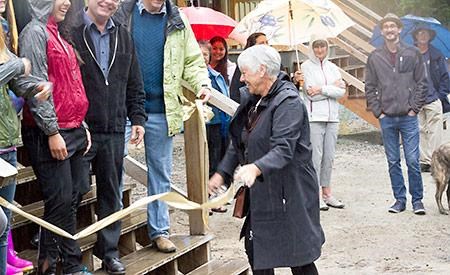School District 47 held its official opening ceremony for the newly constructed Haywire Bay Outdoor Learning Centre June 25.
Approximately 40 people attended the invitation-only opening to listen to speeches from school district officials, Colin Palmer, chair of the Powell River Regional District board, City of Duncan Mayor Phil Kent, Island Coastal Economic Trust (ICET) chair, MLA Nicholas Simons, City of Powell River Councillor Jim Palm and Eagle Walz, president of Powell River Parks and Wilderness Society (PRPAWS).
The newly constructed wilderness camp facilities include a large common hall and shower building, six sleeping cabins, three storage cabins, upgraded road access and improvements to the Sunshine Coast Trail.
The opening began with a Klah Ah Men blessing from Betty Wilson on behalf of Tla’amin (Sliammon) First Nation elder Dr. Elsie Paul.
Board of Education chair Jeanette Scott welcomed everyone to the opening and extended her thanks on behalf of the board and school district.
“Haywire Bay truly represents the realization of dreams of many people in the school district and the community,” said Scott. “It has taken a long time and a great deal of effort and support from within and beyond the school district to achieve this goal.”
The school district started planning the project in 2008.
Scott and Jay Yule, superintendent of schools, extended their thanks to Powell River Model Community Project, the regional district, the ministry of community sport and cultural development and PR PAWS for entering into a partnership and ICET for providing $1.4 million in funding to build the project.
“We also appreciate the ongoing support of the Powell River Parks and Wilderness Society,” said Scott.
The school district leased the land from the regional district for the camp, which is designed for students and persons with disabilities. “For my board this is all about them,” said Palmer pointing to a group of Kelly Creek Elementary School students attending the opening to give tours of the facility. “I’m very pleased that the regional board staff have been working so closely with the school district staff.”
Kent spoke on behalf of the ICET board at the ceremony. “This project showed great promise for benefits not only as an opportunity for recreation and outdoor learning for youth, but it also provides a strong economic benefit for your community and the whole Island Coast region,” he said.
ICET was developed by the provincial government in 2006 with a $50 million fund to invest in economic infrastructure, Kent added. “We’ve now funded 90 projects and leveraged over a quarter of a billion dollars in economic infrastructure across the region,” he said.
Mayor Dave Formosa was unable to attend the ceremony because he was out of town on business, but Palm spoke on his behalf. “This trail, this facility, the hut to hut hiking will be drawing people to our shores and they will see what we have here in our great outdoors,” said Palm. “It’s absolutely incredible and more and more people will get to experience it.”
Simons said that thanks also has to go out to the people in every part of the province of BC because “we all agree that this is the kind of thing that we need to represent our province with.”
“This is something that reflects well on all British Columbians,” Simons added. “We have to thank ourselves for being in a place that projects like this can be promoted and pursued with such skill.”
Walz spoke for PRPAWS and echoed Palm’s comments about this new facility drawing tourists to explore the region. “This is the crown jewel of the Sunshine Coast Trail,” he said. “We will be seeing folks from all over the world coming here being able to use this.”
During the first two weeks of June, the school district held its annual grade seven camps at the facility. Jade Coast and Kelly Creek Outdoor programs have also been using the facility this spring.
“We have to remember, all of this is just infrastructure for the real work that needs to be done, which is the educational component,” said Yule.



